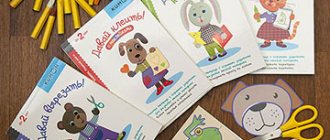The first sounds and words of babies are very funny and provoke uncontrollable smiles in adults. But everyone suddenly stops having fun when they hear incomprehensible phrases from schoolchildren or students. Communication is the most important component of every person’s life. Expressing your thoughts in a structured manner, correctly formulating answers to questions asked, and speaking beautifully and correctly are skills that you should begin to strive for in early childhood.
Unfortunately, most parents do not devote much time to the process of speech development in children. Adults naively believe that it is too early for a child of 5–6 years to go to a speech therapist, they say, all defects will go away on their own as they grow older. But there is a chance that speech problems will not disappear. Often, incorrect pronunciation of sounds in an adult begins precisely with early “dropouts.”
A child with crooked speech is doomed to constant ridicule from others. And if you don’t deal with the problem in time, then in adulthood he will become a terribly complex, withdrawn and uncommunicative person. Today, speech therapists can correct the situation by offering systematic speech development with the help of special games and exercises. However, it is possible to organize educational classes for a child at home.
Types of speech defects
Before starting exercises and activities, we recommend that you understand the main types of disorders in the pronunciation of sounds. A child’s speech may be distorted due to:
- Stuttering. The most common speech defect. It is possible to determine the presence of stuttering in a child closer to the age of 3 years, since during this period he begins to construct his first large sentences. In this case, sessions with an experienced speech therapist cannot be avoided. The specialist will offer games to eliminate the defect and develop speech, which are guaranteed to give a positive result. Stuttering is an insidious problem. It is important not to give up working with your child even after achieving success, because there are often cases when the problem returns.
- Dislalia. A similar defect often occurs in a child 3-5 years old. Without going into science, dyslalia is confusion in the pronunciation of certain consonant sounds (“l”, “r”, “sh” and others). It is worth contacting a speech therapist with this problem as soon as crooked speech becomes noticeable, preferably in the same year.
- Nasality. This phenomenon is also classified as a defect, but the main root of the problem here is in the incorrect structure of the speech apparatus. If you discover such a problem, be sure to contact an otolaryngologist; a speech therapist will not be able to help the child in this situation.
- GSD (general speech underdevelopment). By the age of 6, a child’s speech should be coherent and interesting. If a preschooler experiences certain difficulties when speaking, then most likely the reason lies in the wrong approach to communicating with him. OHP often occurs in children whose parents lisped a lot, distorted endings and uttered only diminutive forms of words. All this created a huge “mess” in the child’s head, which is why the child now independently confuses endings and uses incorrect prepositions. The defect can be eliminated in a timely manner if you take your child to a speech therapist before the age of 6.
- Neurological diseases. If you notice that working with your child at home is not bringing any results, consult a qualified neurologist. Special treatment may be required. It is important to note that a speech therapist will not be able to help your child with this problem.
- SRD (speech development delay). By the age of 3-5, every average child begins to chatter incessantly. If you notice that your baby has a small vocabulary, you should definitely visit a speech therapist for a speech test.
Observe your child and his speech. By regularly communicating with your baby, you will definitely notice the presence of any problems with the pronunciation of sounds. If any are found, be sure to make an appointment with a speech therapist, no matter how old the child is.
A diagnosis of mental retardation is not a death sentence
There are parents who imagine and invent defects for their child. It’s not for nothing that people say: “It’s better to be safe than sorry.” But there are those who point blank see nothing wrong. But by the age of 5, a child should already be able to express his thoughts in understandable phrases. Do not confuse syllables in words.
There are several diagnoses that baffle parents.
- ZRR. When only the word pronunciation is underdeveloped, but mentally the child is fine. It’s good if it is detected before 4–5 years of age, since then another stage begins: zprr.
- ZPRR delayed psycho-speech development. When the child’s psyche and mental abilities are also involved in the process.
- ZPR is just mental development. The speech apparatus also suffers, but the basis here is the baby’s psyche.
I will not talk about the reasons that prompt such states. But, if this happened, then the rule of speech therapists (and all other doctors!) is observed here. And it says: “The sooner the better.” I hope you understand that, as with any disease, there are more complex forms.
Be sure to find a good specialist who will find a common language with the baby. Most likely, a neurologist should also be involved here. But first of all, maintain a good emotional background at home. Believe me, a lot depends on this. Well, now I’ll write recommendations for exercises with mental retardation.
When to contact a speech therapist?
Each child is unique, so language development may vary slightly. Usually by the age of 5 the child already knows how to:
- Pronounce all existing sounds. An exception may be hissing ones, rarely “L”.
- Make sentences of 5-7 words.
- Understand the difference between singular and plural.
- Describe things indicating their main qualities and characteristics.
- Conduct a dialogue with peers and adults.
- Quickly say your first, last and patronymic names and your age.
If a 5-year-old child does not know how to do something from the list, it will be useful for him to attend several speech therapist lessons.
Speech therapy classes for children are aimed at increasing vocabulary, developing fine motor skills and proper breathing, and correcting sound pronunciation defects.
It is worth saying that you should not immediately take your child to a speech therapist. Children develop better at home. Here they feel more comfortable.
Home games for speech development
Speech therapy classes for children - targeted communication with the baby in a playful way.
All existing speech development exercises can be divided into 4 groups:
- finger games;
- articulation gymnastics;
- onomatopoeia and logorhythmics;
- games to expand a child's vocabulary.
Let's look at each category of exercises separately.
Finger games for speech development
Some of the most effective activities for speech development are exercises that involve the use of fine motor skills, since there is a close connection between the human limbs and the brain center responsible for pronunciation. In addition, such games are suitable for children with just developing speech, for example, at the age of 1 year.
Your child will definitely enjoy the following exercises:
- "Flower". In the initial position, form a bud from closed palms, fingers should be raised up, and wrists should be pressed tightly. After the plant blooms, the fingers spread in opposite directions. While doing the exercise, say: “The sun wakes up - the bud opens. The sun is tired - the flower is going to bed.”
- "Kitty." Algorithm of actions for speech development exercises: clench your fists and place them on the surface directly in front of you. Afterwards, you need to simultaneously open your palms and press them firmly to the table. During the process you need to say: “Fist - palm. I stomp like a cat." Repeat 3-5 times, varying the pace.
- "Hedgehog". The child will definitely enjoy this exercise. In the starting position, place your palms at a slight angle and interlace the fingers of both hands. In the process, move your fingers evenly and say: “Tiny cheerful hedgehog. How good are you?
- "The Bird and the Water" Children 5 years old are crazy about this exercise. Initially, you need to place your elbow on the table, raise your forearm and fold your fingers in a “pinch” - this will be a “beak”. When completing the task, lower your “beak” (elbow motionless) and touch the table. In the process, imitate the movements of the bird: take water, straighten your neck, swallow. Accompany the exercise with a tongue twister: “Bent over, picked up, picked up and swallowed.”
- "Chicks in the nest." Gather the fingers of your left hand into a “bunch” - these will be “chicks”. Make a ring with the fingers of your right hand - this will be a “nest”. Send the birds to the nest, taking turns changing hand positions. Add text accompaniment: “Here are the chicks, and here is the nest. The chicks are warm inside.”
Finger gymnastics with learning texts at home is an excellent alternative to regular visits to a speech therapist. Such games provoke the development of speech, teach the use of spatial imagination and develop reaction speed. After a short time, you will notice that the baby begins to remember texts better and speak more expressively.
Articulation gymnastics
Speech therapy classes for 5-6 year old children must include articulation gymnastics, which is a complex exercise for warming up the tongue and lips. The baby’s ability to perform some of the movements necessary for correct sound pronunciation depends on how trained and developed the tongue and lips are. To make activities with your child effective, be sure to use a mirror of the appropriate size. The baby must see how his speech organs work. You don’t need to be a speech therapist to show your child how to do the exercises correctly:
- "Swing". Smile, showing all your teeth. First, lower the tip of your tongue to your lower teeth, then lift it and hide it behind your upper teeth. The result is a kind of swing. Ask your child to repeat the exercise after you 4-5 times while playing.
- “Brushing our teeth.” By the age of 5, children can already keep their mouth clean on their own. In this exercise, you need to imitate brushing your teeth and rinsing them, but without using toothpaste and a brush. Starting position: smile with your mouth wide open. Next, you need to tense the tip of your tongue and clean the lower teeth from the inside with all your might, then lift the tip up and carefully work on the upper teeth. It is important that you cannot close your mouth. Repeat the exercise 8-10 times. Now ask your child to close his mouth and “rinse” it.
- "Jam". You need to smile with your mouth slightly open. Now ask your baby to lick first the upper and then the lower lip with the tip of his tongue. After 10 repetitions, you need to change the direction of movement.
Regular repetitions of these simple speech therapy exercises will actively contribute to the development of speech in a 5-6 year old child.
Onomatopoeia and logorhythmics
Classes with a speech therapist in the clinic often include a block of exercises to develop correct hearing. At home, you can easily create similar conditions to develop your child’s speech and auditory perception with the help of simple exercises. All you need is time, a phone or computer with a speaker, and available tools.
Games aimed at developing hearing:
- "Ears". Take several items made from different materials. Metal and wooden spoons, glass and crystal glasses are suitable. Invite your child to listen to what these objects sound like, then ask him to close his eyes and guess what this thing is just by ear.
- "Meow". Find a recording online with the voices of animals known to your child. Turn it on and ask your child to guess which animal the voice belongs to.
- "Street". Download a recording with the sounds of various vehicles. Invite your child to listen to it and say what kind of transport passed. For recognition, it is better to take familiar types of vehicles - a truck, car, motorcycle, tractor.
- “Where is the noise?” An excellent game for developing spatial hearing. Place the child in the center of the room and blindfold him. Take the bell and walk around it silently, jingling it periodically. The baby needs to identify the source of the noise by ear and point his hand in its direction.
To develop hearing and speech, speech therapists often ask children to imitate the voices of animals and birds, as well as household noises. Take turns saying “tick-tock”, “chick-chick”, “drip-drip”, “woof-woof”, “w-w-w” and the like with your child.
Logorhythmics is a set of exercises that includes the simultaneous use of movement, speech and music (optional). With the help of such games, developing a child’s speech is as easy as shelling pears. Remember about the bull that walks and staggers. Speak the text, show the movements. Let the child repeat after the adults. It will be fun for both the child and you.
Expansion of vocabulary and speech development
For a child, games for speech development, first of all, should be interesting. Tongue twisters are what you need for useful and productive communication in a playful way. Short rhyming phrases are easy to remember, which allows you to seriously expand your baby's vocabulary. A 5-year-old child uses passive and active dictionaries. The first consists of words that he understands, the second - those that he often uses. To improve both vocabularies, be sure to include tongue twister exercises in your speech development games.
Features of practicing hissing sounds
To teach a child to correctly pronounce hissing sounds, you must first introduce whistling sounds. If a child in the fourth year of life has learned to pronounce whistling sounds, then there should be no problems with hissing sounds. You can install them with a few simple exercises.
- "Naughty tongue." The child sticks the tip of his tongue out of his mouth. Then he lightly slaps it with his fingers, while saying: “five-five-five.”
- "Delicious jam." The lower lip is pulled down so that the teeth are visible. And the tip of the tongue licks the upper lip, as if it is very sweet there. At the same time, the lower jaw should remain motionless during the exercise.
- “Hide the candy.” Mouth closed. Tighten your tongue and touch your left, then your right cheek. It's like there's candy hiding behind your cheek.
Repeat exercises at least 5 times.
Note! Producing the sounds of native speech is very important for children. It will help them not only make contact with their peers, but also better master the preschool and school curriculum. Parents have the power to help their children avoid difficulties in the future and put the sounds correctly in time.
Advice for parents of children aged 5–6 years
To ensure that speech therapy exercises are easy for your child and that positive results appear as early as possible, follow these simple recommendations:
- Even if you are not a speech therapist by profession, explain to your child the meaning of the classes. Tell him that all the games are aimed at developing his speech, and the ability to speak beautifully and clearly is an attribute of every adult.
- Speech therapist games with children should be easy. If a child gets carried away by what is happening, he will direct all his forces in the right direction.
- Limit the time your child spends on speech development classes and other school preparation lessons. It is advisable that the exercises be done daily, but not more than 15 minutes each, since it is still difficult for a 5-year-old child to concentrate.
- Praise kids for their successes. It will be much easier to instill a child’s interest in games for speech development if he is sure that he will not be punished, but will be supported.
- Become a role model. The child develops speech from observations of your behavior. Therefore, always speak correctly, clearly and with expression.
No matter how old a child is, improving his speech and helping with all-round development is one of the most important responsibilities of parents. The BrainApps service can be an additional assistant in this difficult task. The portal contains hundreds of highly effective simulators, classes on which will improve memory, attention, thinking and concentration of both adults and children. If you are tired of regular games to develop correct sound pronunciation, try working out with your baby on BrainApps simulators. The result may pleasantly surprise you and your child will probably not need a speech therapist.
Rules for speech therapy classes at home
The success of home lessons depends not only on the availability of the necessary aids and a work plan agreed upon with the speech therapist. The organization of classes itself is very important. Here are a few simple rules that will help you achieve excellent results:
- All speech therapy exercises for children should be carried out regularly, but a little at a time. You shouldn’t try to do articulation gymnastics, play speech games, or fill out a workbook right away. It is better to devote a few minutes to each type of exercise, rather than having a whole “speech therapy day.”
- Do not force them to complete tasks under pressure; educational activities for children should resemble a game. Come up with a simple plot (for example, a journey into the universe of sounds), prepare small prizes (stickers, paper stars), and arrange physical exercises.
- Praise and support the little student if he makes even the slightest progress. Focus on achievements, even small ones, gradually progress will become more and more obvious.
- Find good workbooks for home practice. They should not only be professional in content, but also bright, colorful, and exciting. It is ideal if the tasks have interactive elements (the opportunity to add something, draw something). Such material makes it possible to interest a preschooler and clearly shows him the “path traveled” and success.
- Don't expect instant results, be patient and gentle perseverance. The process of setting, consolidating, and differentiating sounds is complex; it takes months even for experienced speech therapists. Follow the plan and the results will gradually appear.








